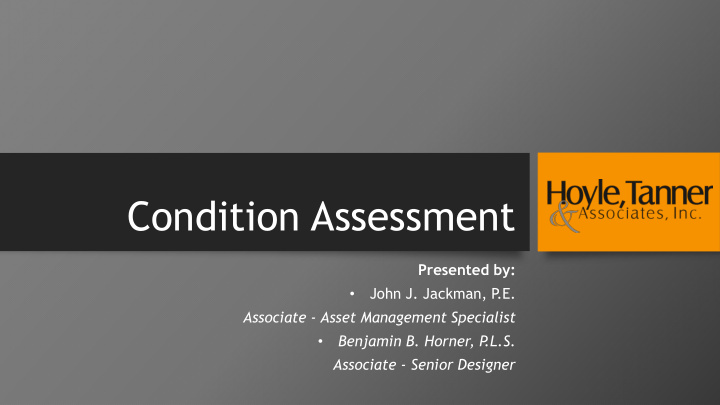



Condition Assessment Presented by: John J. Jackman, P .E. • Associate - Asset Management Specialist Benjamin B. Horner, P .L.S. • Associate - Senior Designer
Agenda • Inspection vs. Condition • Benefits • Developing Condition Assessment • Initial Condition Assessment Techniques • Typical Structural Performance Grades • Condition Standards • Estimating Remaining Useful Life
Inspection vs. Condition • Inspection is the Minimum Acceptable Standard • Condition is a Numeric Rating on the Deterioration Curve
Benefits • Provides Accurate Information About Current and Future Performance • Provides Reference Points on Deterioration Curve • Prevents Premature Expenditures • Provides the Basis for Making Capital Improvement Decisions
Developing Condition Assessment • Current deficiencies • Condition rating assignment • Defect type and extent • Performance • Effective life consumed • Utilization • Capacity assessment • Required Repairs
Initial Condition Assessment Techniques • Visual Assessment • Maintenance History Review • Operational Evaluation • Staff Interviews
Initial Condition Assessment Techniques • Develop standard assessment forms • Assessment tables differ for various asset types • Train for assessment consistency • Complete assessment during routine maintenance • Estimate remaining useful life
Initial Condition Assessment Techniques • Assessment tools • Repair history • Closed Circuit Television (CCTV) • ZOOM Camera • Sonar or Radar • Smoke Testing • Pressure Test • Flow Metering • C-Values Smoke Testing
Condition Standards • Pipeline Assessment and Certification Program (PACP) • Manhole Assessment and Certification Program (MACP) • Pavement Condition Index (PCI) • Federal Sufficiency Rating (Bridge) • Manual on Uniform Traffic Control Devices (MUTCD) (Reflectivity)
Condition Standards - PACP • Structural Defects • Crack • Fracture • Deformed • Collapsed • Joint Break • Surface Damage • Lining Failure Hole • Weld Failure • Point Repair • Brickwork
Condition Standards - PACP • Operation & Maintenance Defects • Deposits • Roots • Infiltration • Obstacles • Vermin Roots Grease
Condition Standards - PACP • Infiltration (Groundwater) • Structural Issues • Operation and Maintenance • Inflow (Inappropriate Connections) • Catch Basins • Roof Drains • Sump Pumps Smoke Testing
Condition Standards – PACP • Typical Defect Grades Grade Condition Comment 5 Immediate Attention Defect Requires Immediate Attention 4 Poor Severe Defects that will Become Grade 5 Defects within the Near Future 3 Fair Moderate Defects that will Continue to Deteriorate 2 Good Defects that have not Begun to Deteriorate 1 Excellent Minor Defects
Condition Standards - PACP • Typical Performance Grades Grade Condition Performance 5 Immediate Attention Collapsed or Collapse Imminent 4 Poor Collapse Likely in Foreseeable Future 3 Fair Collapse Unlikely in Near Future 2 Good Minimal Collapse Risk 1 Excellent Acceptable Structural Condition
Condition Standards - PCI • Two Ways to Measure the Road Network Condition • Only Address Reported Complaints • Preventative Maintenance Based on Condition Assessment • Critical information for each roadway segment • Class - Local Residential, Collector, or Arterial • Length, Width, and Geometry • Traffic Type and Volume • Pavement Type - Flexible, Rigid, or Composite • Original Construction Date • Maintenance and Rehabilitation History • Current PCI Condition
Condition Standards - PCI Airport Runways and Taxiways Roads and Highways
Condition Standards - PCI Weight Index (Wi) Severity of Distress (Si) Density of Distress (Di) Intermittent Throughout Extensive Frequent Very Severe Very Slight Moderate Few Severe Slight <10 10-20 20-40 40-80 >80 Pavement 1 2 3 4 5 1 2 3 4 5 Wi Raveling & loss of surface aggregate Surface Defects 3.0 Flushing 1.5 Rippling and Shoving 1.0 Surface Deformations Wheel Track Rutting 3.0 Distortion 3.0 Single and Multiple 1.5 Longitudinal Wheel Track Alligator 3.0 Single and Multiple 0.5 Centerline Cracking Alligator 2.0 Single and Multiple 0.5 Pavement Edge Alligator 1.5 Half, full and multiple 1.0 Transverse Alligator 3.0 Longitudinal-meander or mid-lane 1.0 Random 0.5
Condition Standards - Federal Sufficiency Rating • Based on an 100 Point Scale • Overall Rating of a Bridges Fitness
Estimating Remaining Useful Life
Estimating Remaining Useful Life • Deterioration curve impacts • Current condition • Environmental conditions • Severity of service • Past experience
Estimating Remaining Useful Life • Determining Rehabilitation/ Replacement Cost • Construction Cost Estimating Guides • Manufacturer Quotes • Cost Data from Previous Bids • Estimate Current Cost from Original Cost
Q & A
Recommend
More recommend